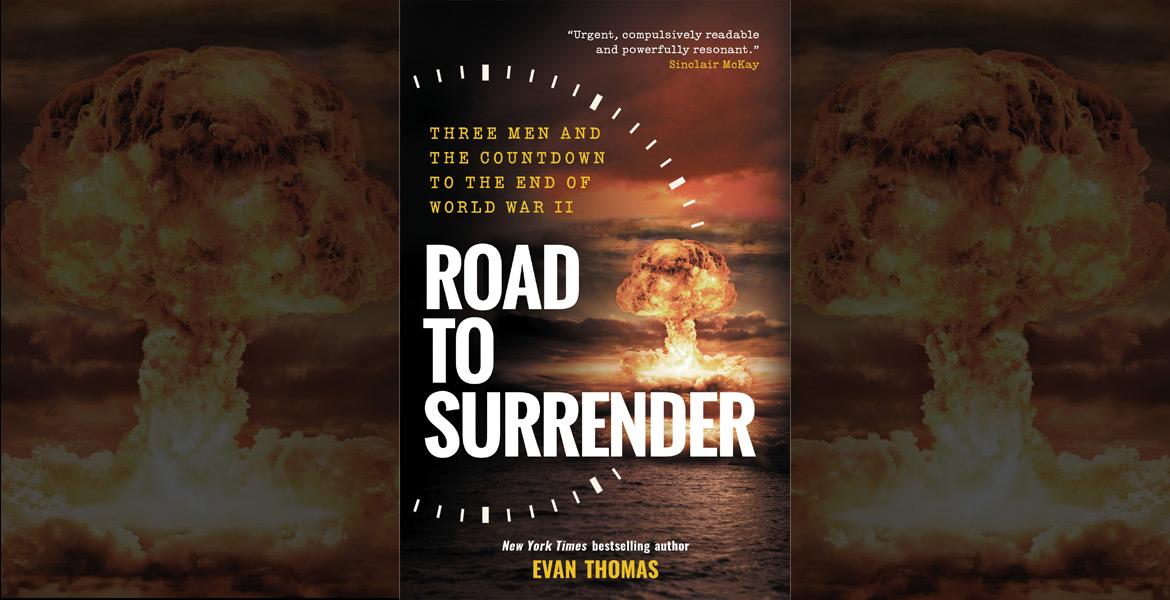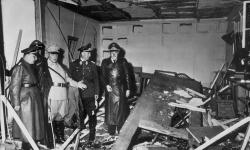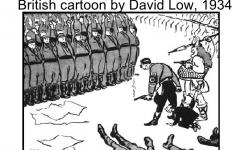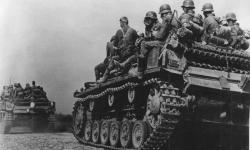Road to Surrender: Three Men and the Countdown to the End of World War II
Guest article by Evan Thomas
In August 1945, after the United States dropped atomic bombs on Hiroshima and Nagasaki and Japan surrendered, the soldiers, sailors, and airmen scheduled to participate in the invasion of Japan reacted as you might expect. They cheered, they danced. Some of them wept with relief. Others sat in quiet disbelief. One infantrySoldiers who fight on foot. officer, who had been wounded in action in Europe and was slated to lead a rifle platoon up a defended beach near Tokyo, recalled thinking, 'We were going to live. We were going to grow into adulthood after all.'
In more recent years, scholars of World War II have argued that it was not necessary to drop the atomic bombs on Japan, or that it was not necessary to drop more than one, or that the Japanese might have been moved to surrender if the United States had staged a demonstration of the bomb’s power on a deserted island. That argument has gained popular currency. When I was writing this book, friends would ask, was it really necessary to drop two atomic bombs? In school and college, many had been exposed to books and scholarship that argued that, by August 1945, Japan was ready to surrender, and that America’s real motivation in dropping the A-bomb was to intimidate Russia in the earliest days of the Cold WarA period of geopolitical tension between the United States and the Soviet Union and their respective allies, 'officially' lasting from 1947 to 1991..
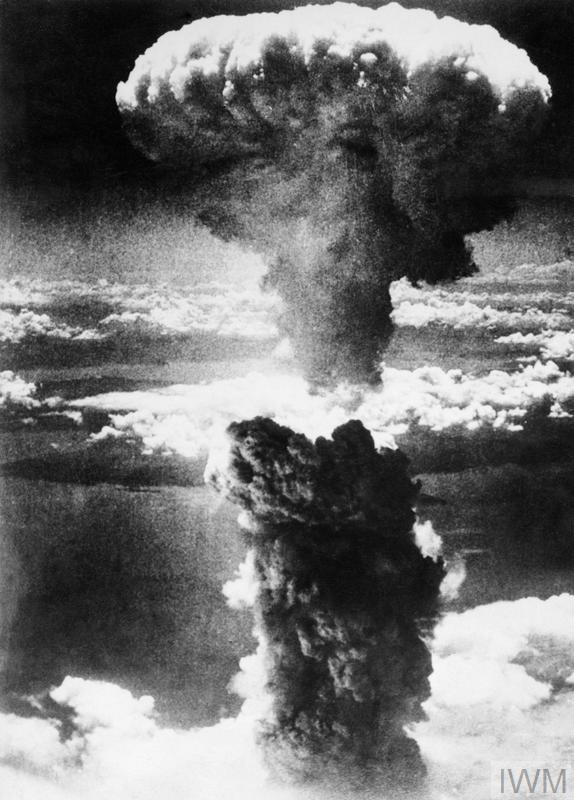
The facts are otherwise. On the morning of August 9, 1945, after the United States dropped two atomic bombs and Russia declared war on Japan, the Supreme Council for the Direction of the War, the group of six leaders who ran Japan, deadlocked on whether to surrender. The vote was a tie, three to three. The most powerful leaders, the ones who ran the army, wanted to keep on fighting. For five more days, Japan teetered on the edge of a coupA sudden, and often violent, illegal seizure of power from a government. d’état by the military that would have plunged Japan into chaos and extended the war for many bloody months. On the last night, coup plotters seized control of the Imperial Palace, running through the halls looking for a recording of the emperor’s voice, to be broadcast the next day at noon, announcing Japan’s surrender. (The recording, fortunately, was tucked away in a room reserved for ladies-in-waiting.) Hot and dark, largely burned out by American firebombs, Tokyo roiled with intrigue and deception, including large doses of self-deception on the part of the leaders responsible for deciding.
In Washington, meanwhile, decision makers were not, for the most part, thinking about the bombs’ effect on the Soviet UnionThe Union of Soviet Socialist Republics (USSR) or Soviet Union, was a Marxist-Leninist state covering much of eastern Europe, Russia and Asia between 1922 and 1991.. They were praying that the bombs would bring Japan to its senses. Indeed, they were seriously considering dropping another. The Washington leaders were not free of their own illusions as they struggled over what to do, but they faced a hard reality. They were actors caught in a dilemma as old as war but never more grotesquely distended: that to save lives it was necessary to take lives — possibly hundreds of thousands of them.
What was it like to be one of the decent, imperfect people who made the decision to use a frighteningly powerful new weapon? How did they choose how many bombs to drop, when, where, and to what end? I learned that the word decision does not accurately describe the fraught, inexorable process that they went through. Were they somehow subject to 'psychic numbing', as scholars have suggested? Many were troubled, even tormented, though they, too, tried not to show it. Duty, mercy, expediency, and ending a four-year war all pulled at them.
The problem for these men — the looming, intractable, seemingly unsurpassable obstacle — was that Japan was unwilling to surrender. By the summer of 1945, the empire appeared to be defeated. Japan’s ships had been sunk, its cities burned, and its people were on the verge of starvation. But its military leaders, who commanded five million soldiers under arms, as well as greater citizen armies equipped with pitchforks and scythes, seemed bent on mass suicide. To attempt to defeat them by invading and seizing territory seemed sure to produce the greatest bloodbath of all time — and the Japanese, or at least their military leaders, beckoned the Americans to it.
The Allied forces assembled a vast invasion armada, including at least a dozen hospital ships, but the projected casualty estimates were so ghastly that even the most upright of men, General George C. Marshall, the chief of staff of the army, invited his subordinates to fudge the numbers. Dropping the A-bomb on Japan was a foregone conclusion. That Japan would surrender was not. The atomic bombs would kill roughly 200,000 people. Had Japan fought on, likely many more people would have died, possibly millions more, in Asia as well as Japan.
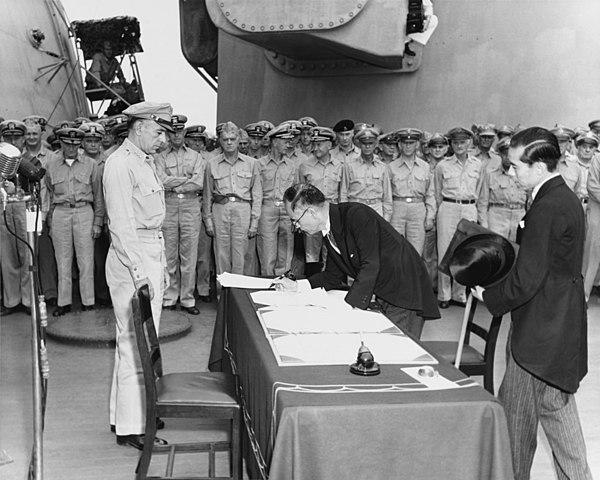
Two weeks after the bombs fell, the Allied armed services staged a magnificent surrender ceremony on a battleship in Tokyo Bay, with wave after wave of American warplanes flying overhead. But I wondered: How did they feel, the decision makers, when the celebration ended and the cheering stopped? What were the complicated emotions of these men, most of them never-complain, never-explain stoics of their generation, practiced in the art of denial?
Occasionally true feelings, or something like them, would slip out. In November 1945 J. Robert Oppenheimer, the chief scientist in charge of developing the bomb at the secret laboratories of Los Alamos, appeared in the Oval Office and cried out to President Truman, 'Mr. President, I feel I have blood on my hands!' According to the president’s account, Truman coolly dismissed Oppenheimer and instructed that 'the cry-baby scientist' never be brought around to him again. Telling the story later, Truman would imitate Oppenheimer wringing his hands. 'I told him the blood was on my hands — to let me worry about that,' said Truman.
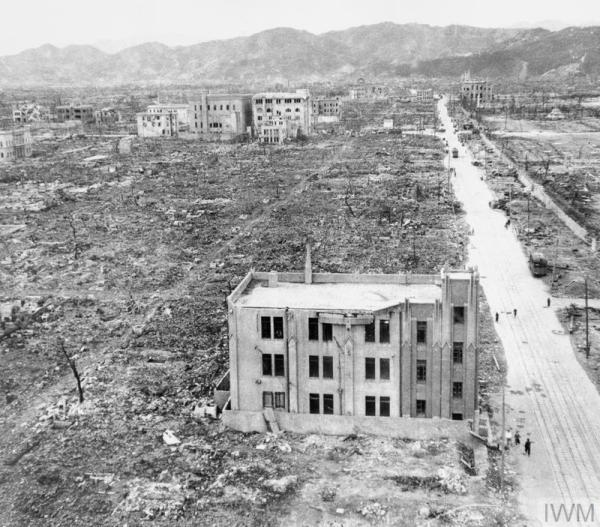
In later years, Truman liked to say that the decision to drop the atomic bombs was his and his alone. The reality was not so straightforward. Major-General Leslie Groves, who ran the Manhattan Project that built the bomb, once scoffed that Truman was 'like a little boy on a toboggan' careening downhill — that he had little or no control over a process that was already well along when Truman took office and essentially unstoppable. Groves’s jibe about Truman is not fair; as commander in chief, Truman did take responsibility, and if he was sometimes opaque or chose to look the other way, that does not distinguish him from other great presidents who were also politicians, notably his predecessorA person who held a job or office before the current holder., Franklin D. Roosevelt. Still, Truman was not the main actor in the story of how America (and its allies) and Japan came to end World War II.
Our story begins and ends with the man who oversaw the building of the atomic bomb and authorized the order to deliver it, FDR’s and Truman’s secretary of war, Henry L. Stimson. Stimson is today a largely forgotten figure. He was, in 1945, a rather antique Victorian with the blind spots and racial prejudices of his time and class. He was old and sick and sometimes absent or seemingly out of the loop as the war ground to its bloody end. And yet in the last act of a long career of public service, he found a way to face up to the conflicting demands of great power. He embodied and preached a philosophy that would make the United States, for all its flaws, the world’s essential nation: the belief that American foreign policy should be a blend of realism and idealism. It should balance humanitarianSomeone or something concerned with human welfare. and ethical values with cold-eyed power used in the national interest.
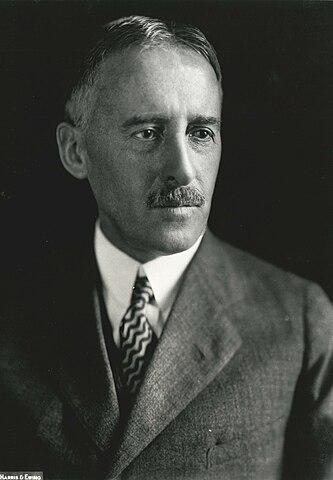
This balance is hard to achieve and maintain. At times, it is impossible. The effort almost killed Stimson in the summer of 1945. On the morning he brought Truman the first photos of Hiroshima, or what was left of it, after the first bomb fell, Stimson had a small heart attack. After he presented the president a month later with the first-ever plan to control nuclear weapons, he had a major heart attack. He was physically frail, to be sure, but his diaries show that he was also suffering from existential anguish.
Stimson signed off on the order to deliver the atomic bombs, and it was sent to General Carl 'Tooey' Spaatz, the army air forces commander assigned to lead the strategic bombing campaign in Operation Downfall, the final assault on the Japanese home islands. The low-key, almost diffident Spaatz was described by General Dwight Eisenhower as 'the best air commander I know'. In Europe, Spaatz had been responsible for orders to drop thousands of tons of bombs at the cost not only of tens of thousands of civilians but also of thousands of soldiers and airmen, including many Americans. He quietly, dutifully, and expeditiously gave and carried out death-dealing orders. But that did not mean that he was not affected by what he was doing. On August 11, 1945, after Hiroshima and Nagasaki had been destroyed by atomic bombs — at his command — Spaatz wrote in his diary (self-consciously, awkwardly, as if he were testifying for the historical record — or before his Maker), 'When the atomic bomb was first discussed with me in Washington, I was not in favor of it just as I have never favored the destruction of cities as such with all inhabitants being killed.' Yet faced with the continued refusal of the Japanese to surrender, he recommended dropping a third atomic bomb on Tokyo, on an area already burned out by firebombs. And indeed, President Truman told America’s British allies that he was resigned to dropping a third bomb — on Tokyo — just hours before he learned of Japan’s surrender on the late afternoon of August 14 (August 15 in Japan).
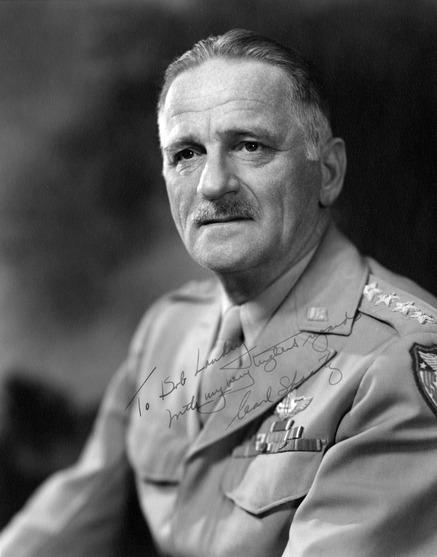
Both Stimson and Spaatz followed a rigid code of duty; both agonized over the brutal means to what they saw as a just end. In my book Road to Surrender, I draw on their diaries and papers, some given me by family members, to help tell what happened, as closely as possible and as it happened — in real time and in the present tense. I do not pretend that these records are precise road maps to the psyches of the people who kept them. Diaries, after all, are often written for posterity — as a record of the way people wish to be remembered. (Spaatz’s diary for August 11, quoted above, may be a case in point.) But at important moments, the diaries and letters of Stimson and Spaatz are remarkably candid about the kinds of inner conflicts that can pull at men who are, outwardly at least, sure of themselves.
Of course, the American side is only half the story, and perhaps not even the most important half. What of the Japanese? What made them finally surrender even after two atomic bombs did not? More than seventy-five years later, Emperor Hirohito remains an enigmatic figure, wrapped in veils by palace courtiers who venerated him as a deityA non-specific supreme being in monotheistic traditions, or a god or goddess.. He revered his ancestors, but he was, in truth, a very mortal being who was not sure which frightened him more — the American B-29 bombers or his own rebellious army officers.
Fortunately for history, a proud, brave, stubborn man, Foreign Minister Shigenori Togo, did more than any other person to bring Japan’s ruling Supreme War Council to accept surrender in the apocalyptic spring and summer of 1945. I draw on unpublished diary entries provided by his grandsons to tell his story, too.
Though Stimson and Spaatz never met Togo — and probably knew very little, if anything, about him — these three men became unlikely partners in averting a cataclysm of death beyond anything the world has ever seen or, one hopes, will ever experience. It was a close-run thing.
Road to Surrender: Three Men and the Countdown to the End of World War II by Evan Thomas (Elliott & Thompson) is published in paperback on 4th July 2024, and can be purchased here.
- Log in to post comments


